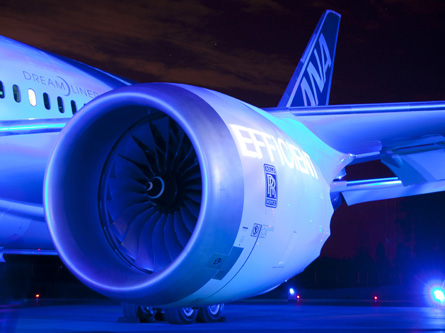Two years ago, Rolls-Royce's Trent 1000 made a splash at Farnborough, powering Boeing's 787 on its debut appearance at the show. Earlier this year, the engine reached its long-awaited entry-into-service milestone with Japan's All Nippon Airways. Although the Qatar Airways 787 on display at this year's show is equipped with the competing General Electric GEnx, the UK manufacturer still has plenty to shout about as it prepares to introduce upgraded versions of the Trent 1000 for the -9 and -10X stretched variants of the Boeing twinjet.
The handful of 787s in the ANA fleet had completed more than 3,000 passenger flights by early June, averaging a combined 35 flights or 70 engine cycles per day. The fleet is expected to grow to 14 aircraft by the end of August.
"It's been the best ever entry into service for a Trent engine, with dispatch reliability around 99.9%," says Trent 1000 programme director Simon Carlisle. "We're very pleased with how the engine is performing in the ANA operation.
 |
|---|
| Rolls-Royce |
"We have a number of reliability engines running [in the test cell] and we have a fleet leader programme, designed to keep the engine well ahead of the fleet in terms of hours and cycles accrued, which in turn allows us to make any changes and improvements needed to ensure that we maintain that high level of in-service reliability."
Real-time monitoring of engine parameters for the ANA fleet by the company's operations centre in Derby is also having a positive impact on reliability levels, says Carlisle, with Rolls-Royce, Boeing and ANA all sharing the same data.
"We have had a number of instances where we have had data coming through that has allowed us to pre-empt questions from the airline. At this stage there are still a few bugs in the system that we're trying to iron out in terms of false messages and so on, which is to be expected," says Carlisle.
The next two operators of Trent-powered 787s will be LOT and LAN, which do not have the same engineering resources as ANA, so the experience gained with ANA, coupled with real-time monitoring, will be vital in order to achieve smooth service-entries with the next customers.
The standard production version of the Trent 1000 is known as "package B", and an improved package C variant is under development to enter service with Air New Zealand on the 787-9 in early 2014. This will become the standard engine for new-build -8s from the second half of 2014.
Further out is an as-yet unlaunched second stretch of the 787, known as the -10X.
"We're talking to Boeing at the moment about the -10X," says Carlisle. "We're getting to quite detailed levels of discussion now, but I'm not going to comment on whether either company will make an announcement at Farnborough. We're certainly at the stage where we're looking to finalise an agreement with Boeing."
The Trent 1000 is already certificated to 70,000lb (329kN) of take-off thrust, but the engine has the capability to go beyond that if required.
"It becomes a question of trades between fuel performance and thrust," says Carlisle. "But the core is big enough to deliver what Boeing needs."
Some technologies from the more recent Trent XWB programme for the Airbus A350 will be fed back into the Trent 1000.
"We are feeding XWB proven designs back into the Trent 1000 as we go forward, and the engine for not only the 787-10X but all the aircraft in the future will have some XWB features," says Carlisle.
"The most significant things for us this year are around getting ready to certify the package C engine and do the flight test on the -9."
Package C provides around a 1% improvement in fuel efficiency achieved through "a combination of aerodynamic enhancements and correcting some of the things we've learned from the package B engine", says Carlisle.
The first package C engine has completed around 76h of testing. Tests onboard R-R's 747 flying testbed will begin later this year, to evaluate its performance at altitude. Certification is scheduled for June 2013, "coincident with the start of flight testing on the -8 and -9. The first flight-compliant engines will go into production at the beginning of 2013," says Carlisle.
The Trent 1000 is also the lead engine for the -9, due to enter service with ANZ on the "critical mission" of Los Angeles-Auckland.
Package C has already been run up to 80,000lb thrust in tests. The main changes - compared with package B - are to the blading in the IP compressor, as well as the introduction of a semi-active low-pressure turbine tip control system, which is "about controlling clearances at altitude to give better fuel burn".
The package C engine will be certificated at 74,000lb, while Carlisle says a study engine for service entry in 2016 is "the engine we're looking at that has the thrust to meet the requirements of the -10X".
The latter engine is projected to offer about a 2% improvement in fuel burn and "one or two other maturity features as well", including reduced temperature margins to boost time on wing. "Probably around 76k is where we will position that engine, but it could do more than that. We're in the final throes with Boeing as to what that should be," says Carlisle.
In terms of the Trent 1000's competitiveness against the GEnx, R-R claims that its engine delivers equivalent fuel efficiency at a range of 3,000nm (5,550km). At shorter ranges the Trent 1000's three-shaft design and intermediate-pressure stage gearbox offtake gives it a slight fuel burn advantage of 1.5%, says Carlisle.
He adds that Rolls-Royce believes the shorter, more rigid three-shaft design of the Trent 1000 also results in lower overall lifecycle costs through better performance retention, delivering a "saving of more than $1 million per aircraft over 15 years", says Carlisle.
Want to read more? Visit our dedicated Fanrborough Air Show 2012 page
Source: Flight Daily News























